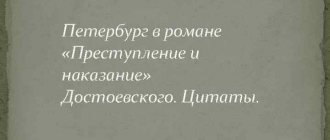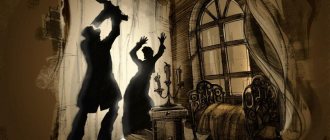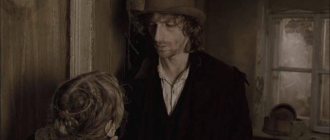- Summary
- Dostoevsky
- Crime and Punishment
Former university student Raskolnikov Rodion Romanovich lived in a small room, he was afraid of his landlady, to whom he owed money for an apartment. His mother and sister lived poorly and could not help him. Sometimes Raskolnikov went to the old woman Alena Ivanovna, from whom he took money as bail. The last time he brought her a watch, given to him by his sister.
On the way home he met Marmeladov. He was fired from service for drunkenness. He told him about his hard life, about his sick wife, about his eldest daughter Sonya, who worked on the panel to feed the family. Raskolnikov remembered his sister, who had previously worked as a maid, and now for the sake of her brother she was going to marry a rich but dishonest man. And then he decides to upset this wedding. He accompanies the drunken Marmeladov home. Where they were met by Marmeladov’s wife, exhausted by lack of money and her husband’s drunkenness, and hungry and frozen children. Raskolnik quietly left them his last money. Impressed by everything he saw and heard, he decides to kill the old pawnbroker. He kills not only her, but also an unwitting witness to his crime - the old woman's sister Lizaveta. Raskolnikov believed that the murder was ideological, but in his soul there was a growing feeling that he had crossed himself off the list of people. When his mother and sister arrived, he was even afraid to hug his family.
Raskolnikov fell ill from constant remorse. His friend Razumikhin looked after him. During Raskolnikov's illness, he met his sister Dunya and fell in love with her. When Rodion felt better, a friend told him that the investigator suspected him of murder. These suspicions arose because of Raskolnikov’s article, which he wrote while still at the university. In it, he revealed his theory about the exclusivity of people, whom he called extraordinary, justifying their permissiveness.
Raskolnikov learns of the death of Marmeladov, and later of his wife Katerina Ivanovna. He goes to Sonya to support her and confesses his crime to her. The girl invited him to repent, to remove sin from his soul. After this conversation, he goes to the police and confesses to the murder. For the crime he committed, he was sentenced to eight years of hard labor. There were many reasons that commuted the sentence: his confession to the murder, the money returned to the penny. They didn’t even forget the incident when Raskolnikov carried two children out of a burning house, took care of a sick comrade for a whole year, and paid for treatment with his own money.
Sonya Marmeladova also goes to Siberia to at least occasionally see Raskolnikov and support him. The convicts treated Rodion badly and called him an atheist. Sonya, on the contrary, was loved and rejoiced at her arrival. She found words of support and consolation for everyone. The prisoners looked at her as if she were a guardian angel.
Raskolnikov bravely endured all the hardships of hard labor, but never found peace in his soul. One day he found out that Sonya was sick. Fear for her life filled his heart with ice. He realized that all the best and brightest in his soul was his love for Sonya. Without her, life lost its meaning. He told her about this at their first meeting after her illness. From that day on, peace and hope for happiness settled in Raskolnikov’s soul.
The novel teaches you to value human life and live according to your conscience.
You can use this text for a reader's diary
Dostoevsky. All works
- Poor people
- White Nights
- Demons
- Brothers Karamazov
- Eternal husband
- Double
- Uncle's dream
- Yershalaim chapters in the novel The Master and Margarita
- Notes from the House of the Dead
- Notes from the Underground
- Player
- Idiot
- Crocodile
- Meek
- The Legend of the Grand Inquisitor
- Boy at Christ's Christmas tree
- Boys
- Netochka Nezvanova
- Teenager
- Crime and Punishment
- The village of Stepanchikovo and its inhabitants
- Bad joke
- Raskolnikov's dream about a horse
- Funny man's dream
- Humiliated and insulted
- Mistress
- Epilogue of the novel Crime and Punishment
I.A.Goncharov and F.M.Dostoevsky
1 part
Considering the idea called “Apathy,” it is easy to understand that the motives of “Oblomov” were not entirely unexpectedly included in the novel “Crime and Punishment.” Moreover, in this novel Oblomov is “present” precisely as a “St. Petersburg product,” a lazy person. To be convinced of this, it is enough to cite Razumikhin’s conversation with Dr. Zosimov about Raskolnikov’s mistress. To Razumikhin’s attempts to bring Zosimov closer to her, the latter responds with the question: “What do I need her for?” Razumikhin explains the matter in words that clearly show one very important feature of Dostoevsky the artist, who turns to someone else’s work. The writer is interested not so much in the phenomenon itself (or detail) depicted by another author, but in the “idea” of this phenomenon, already conceptualized “artistically and theoretically” by Dostoevsky. In Razumikhin’s speech, Dostoevsky gives, as it were, the quintessence of the idea of “Oblomovism”: “Eh, I can’t explain it to you in any way! You see: you both suit each other perfectly! I’ve thought about you before... After all, you’ll end up like this! So does it matter to you - sooner or later? Here, brother, a sort of featherbed beginning lies - ah! And not just one feather bed! Here you are drawn in: here is the end of the world, an anchor, a quiet refuge, the navel of the earth, the three-fish foundation of the world, the essence of pancakes, fatty kulebyak, an evening samovar, quiet sighs and warm katsaveyki, heated beds - well, you’ve definitely died, but at the same time and alive, both benefits at once!” (6, 161). What is interesting here is even the very large number of formulations of “Oblomovism” cited by Dostoevsky, as it was expressed in that part of the novel by I. A. Goncharov, which depicts the idyll of Oblomov’s life on the Vyborg side in the house of the widow Pshenitsyna. Dostoevsky seems to deliberately evoke in the reader’s mind associations with the classical type of Oblomov. The wording “three-fish foundation of the world” is noteworthy - an association most likely also inspired by the novel “Oblomov”. After all, the author compares the Oblomov peasants with the ancient Greeks: “At a certain time, the peasants transported grain to the nearest pier to the Volga, which was their Colchis and the Pillars of Hercules... and then a dark world, unknown countries, began for them, as for the ancients.” Dostoevsky, following Goncharov, emphasizes the historical origin of “Oblomovism,” which dates back to pagan patriarchal times.
Zosimov, in Razumikhin’s perception, is Oblomov’s brother: “You are a nervous, weak piece of trash, you are blessed, you are fat and cannot deny yourself anything - and I call this dirt, because it directly leads to dirt (Razumikhin seems to judge by experience of Oblomov, drawn into the quiet life of Agafya Matveevna - V. and T. M.). You have softened yourself to such an extent that, I confess, I least of all understand how you can be a good and even selfless doctor despite all this. He sleeps on a feather bed (doctor!), and gets up at night for the sick! In three years you will no longer get up for the sick..." (6, 160).
This conversation between Razumikhin and Zosimov clarifies our ideas about Dostoevsky’s perception of Goncharov’s work and, in particular, the novel “Oblomov”. Judging by individual remarks in the preparatory materials for his works, Dostoevsky connected “Oblomov’s Dream” with the theme of “Christ.” In any case, the theme of “Oblomovism” was included in the novel “Crime and Punishment” in the traditional interpretation. The novelist felt Goncharov’s “civilizational” theme of creative work (which is only developed in different ways in “The Frigate “Pallada”” and in “Oblomov”) and gave his understanding of this theme in “Pushkin’s Speech” of 1880: “Humble yourself, proud man... humble yourself, idle man... work hard in your native field” (26.139). This is nothing more or less than a program for leading Russia out of the socio-political and moral crisis, a program for the “Russian path”. Goncharov and Dostoevsky agreed on this (“work an idle man”) in their thoughts about the future destinies of Russia. Goncharov developed his “humble yourself, proud man” in the novel “The Cliff”. But more on that later.
The year 1867 is remarkable for the personal meeting of Goncharov and Dostoevsky abroad, namely in Baden-Baden. This meeting, like a drop of water, reflected the relationship between the writers: calm and friendly Goncharova, on the one hand, and jealous, competitive, on the other. In a letter to S.A. Nikitenko dated June 15, 1867, Goncharov reported: “... I wanted to get down to old forgotten work [1], I took with me the notebooks that had turned yellow with time and did not touch them from the suitcase. Neither health nor work succeeded, and the question of work is resolved negatively forever. I’m throwing down my pen...”[2] Disappointed with his creative failure, Goncharov went to Baden-Baden. Here he met Dostoevsky. Dostoevsky, in a letter to A. N. Maikov, described his meeting with Goncharov in unbiased tones: “But to finish with Baden: in Baden we suffered in this hell for 7 weeks. At the very beginning, as soon as I arrived in Baden, the very next day[3], I met Goncharov at the station. How embarrassed Ivan Aleksandrovich was at first. This state or actual state councilor also played around. But it turned out that it was impossible to hide, and besides, I myself play with too brutal frankness, so he stopped hiding from me. He played with feverish fervor (small, for silver), played all 2 weeks that he lived in Baden, and, it seems, lost significantly. But God bless him, dear man: when I lost completely (and he saw a lot of gold in my hands), he lent me, at my request, 60 francs. He must have judged me terribly: “Why did I lose everything, and not half, like him?” (28.2.208-210). Dostoevsky ironizes and emphasizes the bureaucratic “moderation and accuracy” in Goncharov’s personality. Just like many years ago.
Between “Crime and Punishment” and the novel “The Idiot” there is a certain border in Dostoevsky’s perception of the image of Ilya Oblomov. Back in the mid-1860s. Dostoevsky emphasizes the primitiveness of Oblomov’s characterization (laziness and selfishness). After 1867, perceptions changed significantly. Three weeks after meeting Goncharov in Baden, Dostoevsky met in Basel with G. Holbein’s painting “The Dead Christ,” and almost immediately after that, the initial idea for the novel “The Idiot” was formed in his head. It is interesting that even now the figure of Oblomov continues to be attractive to Dostoevsky. Only this time, the novelist managed to overestimate the large-scale plan of Goncharov’s novel, which was not immediately revealed to him, and the brilliantly captured figure of Ilya Oblomov. Now Dostoevsky is not interested in the superficial everyday features of Goncharov’s hero, but in the evangelical content of this image, which he could not help but feel, again, better than all other contemporaries of Goncharov. The evangelical spirit of the novel, the annoying nostalgic note that permeates Goncharov’s novel not only as a personal motive, but also as an echo of the Gospel parable about “buried gifts,” Dostoevsky was able to consider in the text of “Oblomov.” He also saw the gospel basis of the image of the main character - his extraordinary meekness, invincible by any circumstances: in Oblomov the writer saw features, although vaguely, but reminiscent of Christ. M. A. Alexandrov, who worked in the printing house where Dostoevsky’s magazine “Citizen” was published, recalls: “Subsequently, when I had read “The Idiot” for a long time, I. A. Goncharov was once mentioned in a conversation, and I spoke with great praise about his “Oblomov”, Fyodor Mikhailovich agreed that “Oblomov” was good, but remarked to me:
- And my idiot is also Oblomov.
- How is this, Fyodor Mikhailovich? - I asked, but immediately caught myself. - Oh yes! after all, in both novels the heroes are idiots.
- Well, yes! Only my idiot is better than Goncharov’s... Goncharov’s idiot is petty, there is a lot of philistinism in him, but my idiot is noble, sublime” (9; 419).
K. Blank, in an interesting article “Myshkin and Oblomov,” focuses on the Christological content of Oblomov’s image. She's o.[4] Unfortunately, the American researcher was not familiar with our articles on Christian discourse in Goncharov’s works.[5] In addition, she literally understands Dostoevsky’s confession about “Goncharov’s idiot” and writes: “Oblomov also has in common with the “idiot” Myshkin his helplessness in everyday matters. Due to his inability to “write a paper to the council” and his inability to conduct economic calculations, he, like the prince, becomes a target of financial intrigue. They are both eccentrics, and what they have in common is that they constantly violate the code of secular behavior. Myshkin is eccentric with his immoderate compliments to the guests of the Epanchin salon. Oblomov is equally eccentric when, while visiting the Ilyinskys, he refuses to praise Olga’s singing.”[6] The tension in this parallel is too obvious. The eccentric and touching idealist Ilya Ilyich Oblomov is not an “idiot” at all, and the eccentricity of his behavior while visiting the Ilyinskys is only a sign of excitement and love, but not at all idiocy. Dostoevsky, drawing a parallel between the images of Myshkin and Oblomov, insists not on idiocy at all, but on the fact that both heroes are “not of this world.” At the same time, he emphasizes that his Prince Myshkin is an “absolute” person in this regard, without the admixture of aggravating everyday life and spiritual shortcomings. In a letter to S.A. Ivanova dated January 1, 1868, Dostoevsky explained his plan: “The main idea of the novel is to portray a positively beautiful person... All writers, not only ours, but even all European ones, whoever took on the task of depicting a positively beautiful person, - always passed. Because this is an immense task. Beauty is an ideal, and neither ours nor civilized Europe’s ideal has yet been developed. There is only one positively beautiful face in the world - Christ...” (28.2.251). It is obvious that among the Russian writers who tried to portray a “positively beautiful face,” Dostoevsky counts not only Gogol, but also Goncharov, with his Oblomov. According to Dostoevsky, Goncharov also “gave up.” Therefore, Dostoevsky discerned Goncharov’s intention to write in Oblomov not only a primitive lazy Oblomovite, but also some kind of ideal image. It is obvious that Dostoevsky was still able to discern Christ in Oblomov (“Oblomov is Christ”), and therefore, felt a certain parallelism between Goncharov and his search for an ideal based on original historiosophy. Of course, he could not accept Goncharov’s Christian-civilization pathos, believing that civilization and the ideal of Christ are incompatible. Therefore, he sees in Oblomov only a shadow of Christ, while in his Prince Myshkin he sees a more spiritual, more ideal, “positively beautiful” image. An image from the future. Indeed, in “Notebooks” he writes: “Christianity is the third and final degree of man, but here development ends, the ideal is achieved, therefore, by logic alone, by the mere fact that in nature everything is mathematically correct, therefore, here too it is not maybe irony or mockery - there is a future life” (20.194). That is, if in “Ordinary History” and “Oblomov” the clash of patriarchy and civilization (past and present) is depicted, then in the novel “The Idiot” Dostoevsky depicts the clash of civilization and Christianity (present and future). Oblomov comes to St. Petersburg civilization from the past, Prince Myshkin - from the future. Oblomov's Christian potential is complicated by traits from the past (laziness, apathy, selfishness), while Myshkin's Christian image is taken in its purest form from the future. Both of them have no place in a civilized society, but for different reasons. Hence the difference in the plastic persuasiveness of the images. Oblomov is a sculpted sculpture, an absolutely plastic image, a “dying out” personality, a hero who has been given a quiet death, like a dream. Prince Myshkin does not take root in the real modern world, he is a guest from the future who came from somewhere in the distant Swiss fog - and returns to it, finally showing his holy fool (“not of this world”) traits. In this sense, Dostoevsky was absolutely right when he said: “My idiot is better.”
It should be noted that although Dostoevsky felt the positive beginning of Goncharov’s novel precisely in the image of Ilya Oblomov, from the height of his religious ideal he emphasized the “averageness”, or, if you like, the “groundedness” of Goncharov’s spiritual search, pointing to the image of Stolz as a positive one. in Goncharov’s understanding (which does not fully reveal Goncharov’s plan, but straightens Goncharov’s thought to the point of distortion). In a letter to A. N. Maikov dated March 25 (April 6), 1870, Dostoevsky, who had already conceived The Brothers Karamazov, wrote: “Perhaps I will bring out a majestic, positive holy figure. This is no longer Kostanzhoglo, sir, and not the German (forgot his last name) in Oblomov, and not the Lopukhins, not the Rakhmetovs.” After the word “Oblomov” it is added: “How much do we know: maybe it is Tikhon who constitutes our Russian positive type that our literature is looking for.” Although Dostoevsky felt the religious potential of Goncharov’s novel, he seemed reluctant to fully admit that Goncharov was also a writer “with a religious quest.” Hence the emphasis on the “search” in the field of national mentality (German Stolz). This same emphasis on the national in Goncharov did not allow Dostoevsky to understand the image of Raisky in The Precipice. Just as he declared Oblomov a “St. Petersburg” product, Dostoevsky also calls Raisky a slander against the Russian person: “Man begins everything, sets out to do big things and cannot finish even small things.” This gave Dostoevsky the basis to call the image of Raisky “slander on the Russian character” in a letter to N. N. Strakhov dated February 26, 1869.[7] But the fact is that Goncharov is multidimensional: his novels certainly analyze the national character (in this he followed Gogol), however, a religious search is certainly present and even dominates in them (in this field Dostoevsky was aware of his exclusivity and was only involuntarily forced to admit that in Oblomov there are features of “Christ”).
The development of the same “Christian” line of creative relations between Goncharov and Dostoevsky occurred already in 1877, in “The Dream of a Funny Man,” in which theses from Dostoevsky’s sketches for the article “Socialism and Christianity” are artistically presented. In the “Diary of a Writer” for 1876, Dostoevsky writes about the literature of the 1840s: “This is the same literature that gave us the complete works of Gogol... Then it brought out Turgenev with his “Notes of a Hunter”... then Goncharov, who wrote back in the 40s 1990s “Oblomov” and who at the same time published the episode “Oblomov’s Dream” from it, which was read with admiration by all of Russia! epochal context of Oblomov’s image: from antiquity to modernity. Goncharov lovingly described the childhood of Ilya Oblomov, and at the same time the childhood of all humanity (the idyll of the “Golden Age”), elevating Oblomov’s psychological phenomenon to the pearl of creation. In “Oblomov’s Dream,” Goncharov depicts the depths of not only Oblomov’s individual psychology, but also modern man, breaking away from his natural-patriarchal “umbilical cord”: the epic, unhurried ancient world, quite commensurate with the natural, unstraining forces of man living on earth still under warm, maternal cover of nature and patriarchal society. In this world there is still no idea of the accelerating passage of time, of the need to break oneself in order to achieve abstract goals, of systematicity, of increased responsibility for one’s actions in an alien or hostile environment. Goncharov brings together two huge eras of earth’s history in the reader’s mind. Despite the reader's immediate admiration for Oblomov's Dream, Dostoevsky, with his heightened perception of the idea of the “golden age” and conceptual historical thinking, was only later able to fully appreciate the scale of Goncharov’s plan, his ability to penetrate the field of historical epochal symbols and their expression in an intuitive way. subconscious. Despite the enormous differences in the ways of depicting reality, Dostoevsky also turns to the genre-theme of “dream” when he tries to succinctly and concisely express his historical philosophy, his idea of the main historical phases of human development. “The Dream of a Funny Man” (1877) somehow echoes the core of the concept of “Oblomov’s Dream,” although Dostoevsky’s work lacks the luxurious plasticity of “Oblomov’s Dream.” Dostoevsky largely abstracts from the plasticity of the image, while for Goncharov the main task of the artist lies in the image (and not in the “idea”, which for him does not exist outside the image). Speaking about the “currents of history” that permeate Goncharov’s works, it is impossible to avoid the question of the specificity of the writer’s expression of the historical. For Dostoevsky, history manifests itself as the “history of ideas.” Raskolnikov in “Crime and Punishment” can, for example, try on the Napoleonic idea of “everything is permitted.” It’s different in Goncharov’s novels. The writer is far from directly formulating or denoting what this or that historical analogy is being made for. The story in “Oblomov” and “Obyv” not only forms the background of the novel’s action, it completely permeates the work with its currents and is an explanation of what is happening, an explanation of the characters’ characters. The life of Oblomovka and Malinovka, the life of the Rooks, in their connection with the subsequent evolution of the character of Goncharov’s main character, turns out to be permeated with the air of historical time. Thus, the ancient motifs in “Oblomov’s Dream” are only partial confirmation that Goncharov thinks broadly historically. Behind the local time moment in his works one can see a huge historical retrospective and perspective. Dostoevsky could not help but feel and appreciate this. In “The Dream of a Funny Man” the idea is more formulated, more abstract, more rationally structured than Goncharov’s. Dostoevsky expresses his historical concept more clearly than Goncharov, and after him resorts to the “Dream” genre.[9]
(End to follow)
[1] This refers to the novel “The Precipice”.
[2] Russian antiquity. 1914. T. IV. P. 50.
[3] June 25.
[4] Blank K. Myshkin and Oblomov // F. M. Dostoevsky’s novel “The Idiot”: the current state of study. M., 2001. P. 476.
[5] See: Melnik V.I.I.A. Goncharov as a religious personality: (biography and creativity) // Studia Slavica Hung. 1995. No. 40. P. 23-32; Melnik V.I. On the religiosity of I.A. Goncharov // Rus. lit. St. Petersburg, 1995. No. 1. P. 203-212; Melnik V.I. On the originality of I.A. Goncharova’s religiosity // Russian literature of the 19th century and Christianity. M., 1997. pp. 164 – 172. For a detailed discussion of the novel “Oblomov”, see our work: Gospel beatitudes in the novel Oblomov // Tusculum slavicum. Basler Studien zur Kulturgeschichte Osteuropas. Band 14. Zurich. 2005. P. 171 – 184.
[6] Blank K. Myshkin and Oblomov // F. M. Dostoevsky’s novel “The Idiot”: the current state of study. M., 2001. P. 473.
[7] Dostoevsky F. M. Letters. T. II. M.-L., 1936. P. 169.
[8] Dostoevsky F. M. Complete. collection Op. In 30 volumes. L., 1972-1988. T. 22. P. 105. Further references to this publication are given in the text.
[9] Compare: Angelika Molnar. “Oblomov’s Dream” and “The Dream of a Funny Man” (the relationship between completeness and part in dreams about the “Golden Age”) // I. A. Goncharov. Materials of the International Scientific Conference dedicated to the 195th anniversary of the birth of I. A. Goncharov. Ulyanovsk, 2008. An article by Hungarian Slavist Anzhelika Molnár is devoted to a comparison of “Oblomov’s Dream” and “The Dream of a Funny Man.” True, this comparison is made at such a general level that at least the internal, authorial context of both works is not affected. Moreover, the text itself of “Oblomov’s Dream” and “The Dream of a Funny Man” is almost not touched upon. Hence the extreme abstraction of the conclusions, which, in fact, add little to the understanding of the creativity and worldview of both writers, not to mention their comparison: “Summarizing our brief analysis, we can come to the conclusion that the literary dreams about the Golden Age that we are considering at different levels expand the problematic completeness and part, which is a metapoetic reflection of the metonymic connection between the integrity of the myth and the fragmentary nature of the dream, the cell from which the subjectivity develops, generating the text. The problematics of dream and myth, whole and part, posed at the beginning, are revealed in parallel both in thematic motifs and in the semantic world of texts, and moreover creates special narratives in these two works of literature. The part (dream), in which the complex world of the Golden Age is created from details, represents formation in Dostoevsky, a departure from the “tornness and fragmentation” indicated by the “fall”, and a generalized, closed image in Goncharov, including “breaking” and “ fall” (p. 343).
The work was carried out with the support of the Russian Humanitarian Fund. Grant No. 11.34.00219a1 “I.A. Goncharov and his entourage. Dictionary.Reference book."







